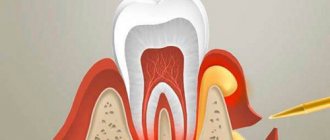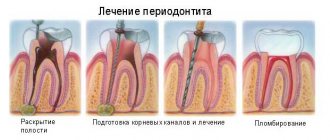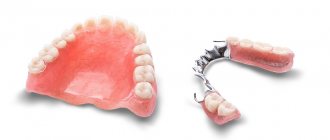What is an oral abscess?
An oral abscess is an acute inflammatory disease characterized by the formation and accumulation of pus in the tissues of the gums, tongue or cheeks. The abscess is accompanied by local swelling and hardening of soft tissues, severe pain on palpation, fever and general weakness. The disease is diagnosed by a dentist after a visual examination of the tissue, after which immediate surgical intervention is required: opening the abscess, followed by cleaning and taking anti-inflammatory drugs.
Oral abscess is one of the most common complications in the practice of dental surgery. It can be observed in patients of different ages. Untimely treatment can lead to the transition of inflammation to the chronic stage. Against this background, sepsis and phlegmon can develop. That is why, if the slightest symptoms of an abscess occur, you should immediately visit a dentist.
Gum abscess - symptoms
A limited focus of infection in the gum most often forms during an exacerbation of existing periodontal pathologies, so signs of an abscess appear suddenly and grow rapidly. Quite pronounced local symptoms are characteristic, and due to intoxication with waste products of bacteria, the general condition also worsens.
An abscess is accompanied by the following symptoms:
- severe pain in the gums;
- limited tissue swelling (“flux”);
- temperature increase;
- redness and swelling of the mucous membrane;
- sometimes – tooth mobility;
- headache, weakness.
In the absence of timely treatment, a fistula can form - a canal in the gum with a hole through which pus spontaneously discharges from the lesion to the outside. After the fistula appears, the pain is relieved, but an abscess remains on the gum, treatment of which is necessary to completely relieve the infection.
Types of abscess by location
An abscess is classified based on the location of the inflammation. The following types of pathology are distinguished:
Gum abscess The most common type, inflammation forms near a specific tooth. If left untreated, an abscess can provoke: leakage of pus from the formed fistula, putrid odor from the mouth and intoxication of the body. Abscess of the floor of the mouth Forms under the tongue, which causes severe pain and discomfort during communication or eating. When the abscess spontaneously opens, the infected fluid pours into the oral cavity and can provoke a new outbreak in the pharynx and neck. Abscess of the palate Occurs against the background of uncured or previous periodontitis of the teeth of the upper jaw. In the future, inflammation can spread to the peritonsillar region and other tissues of the palate, leading to osteomyelitis of the palatal plate. Cheek abscess The depth of damage to this area of the mucosa determines the localization of inflammation, which can sit inside the cheek or extend to the outer surface. Such abscesses are extremely dangerous, because the infection can affect nearby facial organs and tissues. Tongue Abscess Obvious signs include a swollen tongue, pain during meals, and difficulty communicating and breathing. This type of abscess, according to doctors, is the most dangerous and requires immediate treatment.
Purulent gum abscess
At the initial stage of the disease, the inflammation may contain only serous exudate and be accompanied by moderate pain and swelling. Treatment of this condition can be conservative (medication) without surgery. Over time, as a result of pathological processes, pus appears at the site of inflammation, the pain increases and often becomes pulsating. In the area of one or two teeth, a purulent abscess forms on the gum, the treatment of which requires surgical intervention.
Accumulating pus contains interstitial fluid, dead immune cells and microorganisms. As the disease progresses, the amount of pus increases and the pressure inside the abscess increases, microcirculation disorders worsen. Under such conditions, the risk of infection spreading to surrounding tissues and the development of complications increases.
Causes of development of abscess in the oral cavity
An abscess in the oral cavity occurs as a complication of advanced periodontal disease and periodontitis. These diseases are characterized by damage to the teeth and gums with the subsequent formation of pockets in the periodontium. They accumulate pathogenic microorganisms that provoke inflammation. Among other things, an abscess can occur due to infection in a damaged area of soft tissue (trauma, syringe needle, instrument). The cause of the disease is often staphylococcal and streptococcal sore throats, as well as boils on the face.
Inflammation in the oral cavity also appears as a complication after suffering from influenza or ARVI, which weaken the immune system, as a result of which the body is not able to fight infection.
We know how to cure ORAL ABSCESS
In the near future, a medical coordinator will contact you and advise you on the conditions and cost of treatment, select a doctor and make an appointment for you.
| Make an appointment | Or call us +375 29 699-03-03 +375 33 319-03-03 |
Symptoms
The abscess is characterized by rapid development. At first, the patient may be bothered only by minor attacks of pain, similar to the sensations that arise during caries or periodontitis. Subsequently, the pain is localized in one place and gradually increases. In a specific place there is swelling, sometimes a new formation on the gum, sometimes reaching the size of a walnut. If the inflammation is localized closer to the outer surface, then swelling and redness can be observed with the naked eye. If you notice the first symptoms, we recommend that you consult a dentist.
An abscess of the tongue is characterized by an increase in the organ's volume, difficulty swallowing, chewing, and even suffocation. Any abscess is accompanied by fever, deterioration and general weakness, insomnia, and loss of appetite. The progression of the disease leads to a breakthrough of the abscess, which is manifested in a decrease in temperature, a decrease in swelling and an improvement in overall well-being. However, there is no reason to stop treatment, since inflammation can continue and develop into a chronic form. This can lead to tooth loss, sepsis and phlegmon.
Why is an abscess dangerous?
The tissues of the oral cavity are rich in blood vessels, so it is easy for infectious pathological processes to spread from one area to another. A limited abscess without treatment can lead to the following local complications:
- abscess of the adjacent area;
- phlegmon - diffuse tissue damage by infection;
- periostitis – transition of inflammation under the periosteum;
- inflammation of the bone - osteitis.
In particularly severe clinical cases, if the symptoms of an abscess are ignored for a long time, osteomyelitis can develop - melting of part of the jaw bone tissue as a result of purulent inflammation. Pathology leads to the formation of voids in the bone, jaw fractures, and tooth loss.
An abscess in the area of the retromolar fossa (near the last chewing teeth) is especially dangerous, since the infectious-inflammatory process without adequate treatment can spread to the tissues of the pharynx, and from there to the mediastinum, which leads to serious complications from vital internal organs. Another possible way for the infection to spread is into the membranes of the brain, which leads to the development of meningitis. An abscess on the gum without treatment can also be complicated by sepsis when a large number of bacteria enter the bloodstream, which is life-threatening for the patient. You should not postpone a visit to the dentist if there are signs of inflammation of any location, since self-treatment of an abscess with purulent contents leads to a worsening of the condition and serious consequences.
Treatment of oral abscess
Treatment of an abscess requires surgery. In order to eliminate the source of infection and stop the spread of inflammation, the dental surgeon step by step:
- opens an abscess;
- drains the cavity;
- cleans the pocket;
- Rarely applies stitches if the size of the incision is large.
After removal of the pus, the patient’s well-being improves, and facial geometry is restored. Taking antibiotics, antihistamines, immunostimulants and a vitamin complex significantly speeds up the healing process. Sometimes the doctor may prescribe physiotherapeutic procedures (UHF therapy and fluctuarization).
For some time, the patient needs to exclude solid foods from the diet and adhere to healthy eating rules.
Diagnosis and treatment
The diagnosis is made on the basis of clinical studies:
- Collecting the patient's medical history. The doctor listens to complaints and asks questions about symptoms and other manifestations.
- Inspection. It is carried out to identify the causative tooth. The doctor evaluates the color of nearby tissues, the symmetry of the face, and checks the opening and closing of the jaw.
- Palpation of lymph nodes. Their increase indicates the presence of inflammation.
- Measurement of temperature and blood pressure. Deviation of indicators from the norm indicates intoxication of the body.
- X-ray (spot shot and orthopantomogram). It is carried out to establish the localization of the purulent focus.
- Electroodontodiagnostics. Necessary to assess the condition of the dental nerve in the causative tooth.
- Lab tests.
If necessary, general clinical studies are prescribed, such as an electrocardiogram and fluorography.
Material is taken from the opened lesion to assess the sensitivity of the microflora to the effects of antibiotics.
Prognosis and prevention of oral abscess
The success of treating oral abscesses depends on at what stage of the disease the patient seeks help and how strong the body’s defense mechanism is. With timely treatment, the prognosis for eliminating inflammation is quite favorable. In the absence of complications, strong immunity and a high-quality opening of the lesion, an oral abscess can be cured in a couple of weeks.
Prevention of the disease consists of following the following recommendations:
- regular teeth cleaning and professional oral hygiene at least once every six months;
- minimizing the risk of injury to the mucous membrane;
- timely treatment of caries and periodontal diseases;
- visiting a dentist for a preventive examination once every 6 months.
Opening a paratonsillar abscess
The choice of surgical incision is determined by the localization of the inflammatory process in the peritonsillar tissue. The operation is performed under local anesthesia.
- achieve sufficient opening of the patient's mouth. An anesthetic is injected with a thin needle using a syringe (2% novocaine solution, lidocaine, ultracaine in the absence of contraindications);
- the location of the opening of the abscess depends on its location;
- immediately after opening, tilt the patient’s head down so that the pus released under pressure does not enter the respiratory tract. Emptying the abscess cavity leads to a rapid improvement in the patient's condition;
- gargling with antiseptic solutions and monitoring the drainage of the abscess cavity is necessary in the next 2-3 days.
After opening the abscesses, the throat is rinsed with antiseptic solutions; it is recommended to re-open the edges of the incision due to the fact that in the first day after opening, pus can again accumulate in the abscess cavity, and the edges of the incised mucous membrane quickly begin to regenerate. After draining the abscess cavity, inflammatory changes in the pharynx undergo reverse development, body temperature normalizes, pain when swallowing disappears, and overall well-being improves. In the complex treatment of peritonsillar abscesses, antibacterial drugs, anti-inflammatory drugs, and desensitizing drugs are used. In case of severe general intoxication, infusion and detoxification therapy is recommended.








